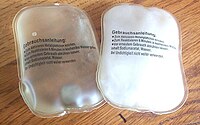
Photo from wikipedia
Graphene oxide (GO)/boron nitride (BN) hybrid porous scaffolds (HPSs) with the optimally three-dimensional (3D) aligned network structure are fabricated using an unidirectional ice-templated strategy. A variety of HPSs with multilayer… Click to show full abstract
Graphene oxide (GO)/boron nitride (BN) hybrid porous scaffolds (HPSs) with the optimally three-dimensional (3D) aligned network structure are fabricated using an unidirectional ice-templated strategy. A variety of HPSs with multilayer structure are obtained due to the various temperature gradients generated by tuning freezing temperature, in which GO and BN are expelled from the ice growth front to assemble between the oriented ice crystals. We demonstrate that the obtained HPSs have a significant influence on the properties of the resulting composite phase change materials (PCMs), including thermal conductivity and shape-stability. Various thermally conductive pathways are formed by tuning freezing temperature, which contributes to further understanding the relationship between thermal conductivity of composites and their internal network structure. Upon increasing the freezing temperature from −120 to −30 °C, the thermal conductivity of the composite PCMs increases and reaches a maximum value at −50 °C ...
Journal Title: ACS Sustainable Chemistry & Engineering
Year Published: 2018
Link to full text (if available)
Share on Social Media: Sign Up to like & get
recommendations!